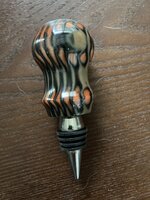Hello! New to the forums and still rather new to turning, hoping to learn some things here. I know this forum is focused on pen turning; my question pertains to bottle stoppers but I have to imagine the theory and techniques are similar enough to bear on my issue.
So the CA finish on virtually every stopper I have turned recently has cracked within anywhere from an hour to a couple of days after applying it. I am trying desperately to figure out if it is the product or the application so that I can avoid having to redo my work. I have been doing what research I can to try to narrow down cause, and finally decided it might be faster to simply ask those who know better than I do.
Everything I can think of that is relevant:
-My stepdad (owns the lathe and work space) stores his CA and other supplies in an un-insulated garage. Being in Western NY, on cold days the interior of the garage can get down close to freezing if not below on the really brutal days.
-We have been using Stick Fast Thin CA on these products. I'm not sure how old the bottle in question is, the bottle is nearly empty so it could potentially be older than 6 months or even a year.
-For application I typically will do 8-10 thin coats of the Stick Fast Thin with a quick shot of Accelerator between each coat. This is the method my stepdad uses for his pens, and he doesn't seem to have any issues with the CA cracking.
-The cracks mostly seem to start in an area where there is an edge or a smaller radius curve in the blank, then propagate slowly through the rest of the finish.
-The cracks do not appear to reach the surface of the finish but are rather in the inner layers.
So I'm not sure if I need to try a newer bottle (we are also looking at GluBoost as an alternative), or give the Stick Fast more time between coats. I've also been speculating that with the larger amount of blank material in a bottle stopper that the Thick Fast Thin may not be flexible enough to handle any movement of the blank material after application.
I appreciate any thoughts or suggestions that anyone may have. I really enjoy creating these pieces but the finish is driving me nuts. Every time I think I have completed a piece and the finish is beautiful, when I look at it later it is spidered with cracks. I can provide photos if it would be helpful. Thanks!
So the CA finish on virtually every stopper I have turned recently has cracked within anywhere from an hour to a couple of days after applying it. I am trying desperately to figure out if it is the product or the application so that I can avoid having to redo my work. I have been doing what research I can to try to narrow down cause, and finally decided it might be faster to simply ask those who know better than I do.
Everything I can think of that is relevant:
-My stepdad (owns the lathe and work space) stores his CA and other supplies in an un-insulated garage. Being in Western NY, on cold days the interior of the garage can get down close to freezing if not below on the really brutal days.
-We have been using Stick Fast Thin CA on these products. I'm not sure how old the bottle in question is, the bottle is nearly empty so it could potentially be older than 6 months or even a year.
-For application I typically will do 8-10 thin coats of the Stick Fast Thin with a quick shot of Accelerator between each coat. This is the method my stepdad uses for his pens, and he doesn't seem to have any issues with the CA cracking.
-The cracks mostly seem to start in an area where there is an edge or a smaller radius curve in the blank, then propagate slowly through the rest of the finish.
-The cracks do not appear to reach the surface of the finish but are rather in the inner layers.
So I'm not sure if I need to try a newer bottle (we are also looking at GluBoost as an alternative), or give the Stick Fast more time between coats. I've also been speculating that with the larger amount of blank material in a bottle stopper that the Thick Fast Thin may not be flexible enough to handle any movement of the blank material after application.
I appreciate any thoughts or suggestions that anyone may have. I really enjoy creating these pieces but the finish is driving me nuts. Every time I think I have completed a piece and the finish is beautiful, when I look at it later it is spidered with cracks. I can provide photos if it would be helpful. Thanks!

